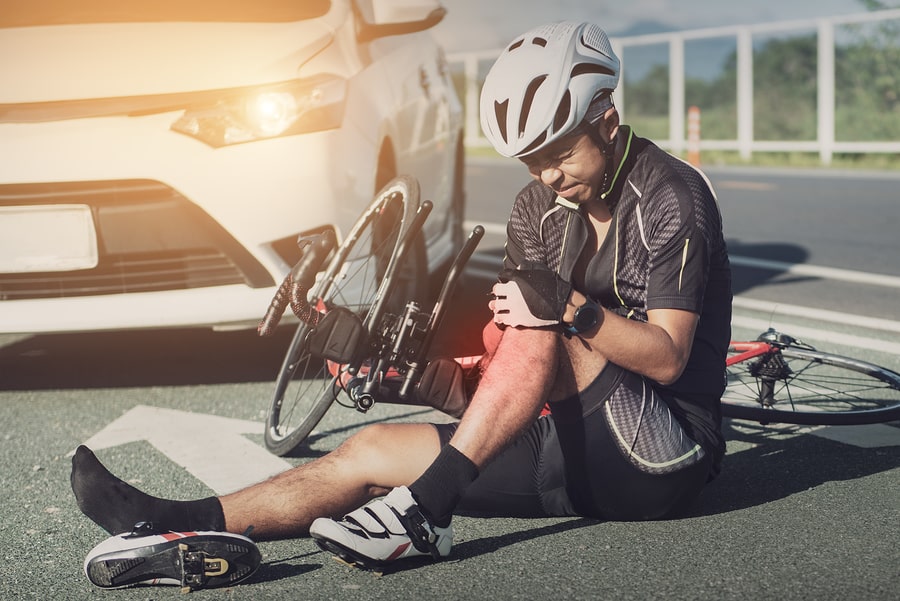
Going for a bicycle ride through town or on a trail can be a pleasurable activity—especially in the spring and summer months. Riding a bicycle is also good exercise that can help keep people of all ages in good physical shape. However, riding a bicycle can also be a dangerous activity, most especially in busy road conditions where a lot of traffic is present.
One of the most significant dangers associated with bicycle rid\ing is the lack of protection surrounding the bicycle rider. Although helmets do a great deal to keep bicycle riders safe, they cannot protect the rest of a person’s body from sustaining a serious injury in an accident. Moreover, if the bicyclist is involved in a serious accident, his or her helmet might crack, resulting in a traumatic head or brain injury.
Although there are certain safety steps and precautions that cyclists should follow to avoid suffering an injury in an accident, there are some factors that are beyond the cyclist’s control—including negligent and distracted motor vehicle operators who are not paying attention to their surroundings.
If you or a person you love has suffered an injury in a bicycle accident that resulted from someone else’s negligence, you are not alone. Our experienced Lawrenceville personal injury lawyer in your jurisdiction can assist you with filing a claim or lawsuit against the person or persons who caused your accident. Your lawyer can help you meet your legal burden of proof and pursue monetary compensation from the at-fault party.
National Statistics Regarding Bicycle Accidents
Bicycle accidents are unfortunately a common occurrence throughout the United States today. Given the serious nature of bicycle accidents, the National Highway Traffic Safety Administration and the Centers for Disease Control and Prevention (otherwise known as the CDC) have compiled numerous statistics on the bicycle accidents that occur throughout the country, as well as the locations of these bicycle accidents, bicycle helmet statistics, and the most dangerous times of day to ride a bicycle.
Bicycle Accidents in the United States by the Numbers—Fatalities and Injuries
Bicycle accidents, especially fatal ones, have been a prevalent nationwide occurrence in recent years. For example, in one year, approximately 783 fatal bicycle accidents occurred as a result of collisions with motor vehicles. The numbers for the three prior years were 840, 818, and 729, respectively. Moreover, almost 467,000 people across the United States in a single year sustained an injury in a bicycle accident. Reports indicated that greater than two percent of fatalities in traffic accidents involved cyclists.
Common Locations for Bicycle Accidents Throughout the United States
Bicycle accidents are more prevalent in urban areas than in rural areas, as more traffic is present in the city than in the country. Statistically, almost 71 percent of fatal bicycle accidents that occurred in a year happened in an urban area. During that same year, nearly 30 percent of fatal bicycle accidents took place at a traffic intersection. Surprisingly, four percent of these accidents transpired when the cyclist was operating his or her bicycle in a designated bike lane.
Bicycle Helmet Statistics
It goes without saying that bicycle helmets can prevent head and face injuries in the event of a bicycle accident. Consequently, some states throughout the country have made riding a bicycle without a helmet illegal. Having these laws in place also works to encourage bicycle riders to wear their helmets at all times when they are operating their bicycles on the road. Despite these laws, however, less than half of all cyclists wear a sufficient and sturdy helmet when operating their bicycles. Moreover, older bicyclists are statistically less likely to wear a helmet when biking than younger cyclists.
Dangerous Times of Day to Operate a Bicycle
In a recent year, slightly more than one-half of all fatal bicycle accidents that occurred throughout the United States happened during the day, while about 45 percent of these fatal accidents occurred at night. Approximately three percent of these accidents happened at dusk, while about two percent took place at dawn.
In that same year, the majority of fatal bicycle accidents on weekends (26 percent) and on weekdays (20 percent) happened in the evening, between the hours of 6 p.m. and 9 p.m.
Approximately 21 percent of these fatal bicycle accidents happened at some point between 9 p.m. and midnight on the weekend. On weekdays, about 16 percent of fatal bicycle accidents transpired in the morning hours, between 6 a.m. and 9 a.m. (and between the hours of 3 p.m. and 6 p.m., Monday through Friday).
Ages of Bicycle Accident Victims
Bicycle accidents can occur among bicycle riders of any age group. For example, approximately 84 percent of fatal bicycle accident victims in a recent year were male. Moreover, the majority of male bicycle riders who suffered injuries in an accident were between 55 and 59 years of age.
Adults between the ages of 50 and 59 have the highest fatality rate in bicycle accidents across the country. Male bicycle operators are approximately four times more likely to suffer an injury, and approximately six times more likely to be involved in a fatal crash while riding a bicycle, than female bicycle operators.
Bicycle Accident Injuries
Bicycles afford their riders very limited protection in the event of a collision. As a result, bicycle riders involved in collisions can suffer very serious injuries, including those that are debilitating and/or last the rest of the victim’s life. The most serious injuries in bicycle accidents occur when a cyclist is thrown from the bicycle onto the ground, resulting in a hard impact. In the process, a bicycle accident victim can suffer serious injuries to his or her hands, arms, legs, face, head, neck, or back.
Some of the most common injuries that bicycle accident victims may suffer include:
- Traumatic brain or head injury – When a bicyclist falls from his or her bicycle onto the ground, the cyclist can suffer a traumatic head or brain injury, or, in some cases, permanent brain damage. Although a helmet helps to lessen the blow of a forceful impact with the ground, helmets can still crack and allow serious head injuries to still occur.
- Bone fracture – When a cyclist falls from his or her bicycle onto the ground in an accident, the cyclist might suffer a bone break or fracture. In most cases, a broken bone requires surgery or some other medical intervention to correct.
- Soft tissue injury – A soft tissue injury is a muscular sprain, strain, or contusion that cyclists can sustain in an accident. In many instances, these types of injuries are treatable through physical therapy and home exercises. Although soft tissue injuries do not involve any broken bones, these injuries can still be serious and extremely painful.
- Spinal cord injuries – A spinal cord injury may occur in a bicycle accident when the bicyclist falls from his or her bike onto the ground and lands on the neck or back. Spinal cord injuries can lead to an inability to function, incontinence, and certain types of paralysis. These injuries can also affect accident victims for the rest of their lives.
Typical Causes of Bicycle Accidents
In many instances, bicycle accidents are the result of negligence on the part of a motor vehicle operator. Motor vehicle operators are responsible for driving their cars and trucks in a reasonable manner at all times. This includes following all of the rules of the road and refraining from certain activities, such as speeding, running red lights and stop signs, and engaging in distracted driving. Distracted driving typically involves paying attention to some form of technology, such as a cell phone, GPS device, or electronic tablet, instead of giving full attention to the road.
When a motor vehicle operator behaves in a negligent and unreasonable manner, and a bicycle accident results, then the motor vehicle operator can be liable for the injuries and damages that the bicycle accident victim sustained.
If a motor vehicle operator is acting as an agent of someone else, such as an employer, and the accident occurs within the scope of that agency or employment, then the owner of the vehicle may share in some or all of the responsibility for a bicycle accident. Moreover, if the motor vehicle owner negligently entrusted the vehicle to a known irresponsible driver, then the owner may be responsible for all injuries resulting from the bicycle accident.
In some limited cases, bicycle accidents result from a defective part or mechanism on the bicycle that malfunctions, leading to an accident that injures the rider. When this happens, the accident victim may file a claim or lawsuit against the bicycle parts manufacturer in a products liability claim.
If you suffered one or more injuries in a bicycle accident that resulted from another person’s negligence, an experienced bicycle accident attorney near you can file a claim on your behalf, or bring a lawsuit against the person or persons responsible for your accident. Our Duluth personal injury lawyer can then file a claim for damages that will help to make you whole again after your accident.
What to Do if You Are in a Bicycle Accident
If you are involved in a bicycle accident, there are certain actions that you should immediately take. If you can do so, you should first call 9-1-1 to report the accident and request police and EMTs be dispatched to the scene.
You should speak with the police officer about the circumstances surrounding your bicycle accident, what you observed. Confirm that the police officer is preparing a written report, as a police report can become an important piece of evidence if you need to file a claim or lawsuit arising out of your bicycle accident.
You should also speak with any eyewitnesses who may have seen what happened. Again, these individuals may serve as potential witnesses at trial, in case the at-fault individual disputes liability for the accident.
One of the most important steps that you should take following a bicycle accident is to seek prompt medical treatment at a hospital emergency room or urgent care facility. Healthcare providers will examine you, take X-rays and MRIs, and make follow-up treatment recommendations that depend upon the nature and extent of your injuries. Seeking prompt follow-up medical treatment after a bicycle accident also shows the at-fault person’s insurance company that you are taking your injuries seriously.
Finally, as soon as possible after your accident, you should speak with a knowledgeable bicycle accident lawyer in your jurisdiction. If the lawyer accepts your claim, he or she will begin to gather important pieces of documentation, including any police report, along with your medical records and bills. Our personal injury lawyer in Peachtree Corners can then submit this documentation to the insurance company as evidence, to pursue a settlement offer on your behalf.
If the insurance company offers a settlement that you deem to be too low, you can continue negotiating with the insurance company. However, if the insurance company refuses to offer you fair compensation for the injuries that you suffered in your bicycle accident, you and your lawyer may decide to file a lawsuit and pursue litigation.
Just because you file a lawsuit in your bicycle accident case does not necessarily mean that your case will proceed all the way to trial. In fact, the case could settle at any point along the way, and most cases resolve in an out-of-court settlement.
As part of your bicycle accident claim, you may pursue monetary compensation for all of your medical treatment bills, lost earnings, loss of earning capacity, pain and suffering, loss of spousal support and companionship, inconvenience, and permanent disability. Contact an experienced bicycle accident attorney in your jurisdiction who will make it a priority to pursue the maximum amount of monetary compensation available for the injuries that you suffered in your bicycle accident.














